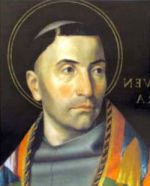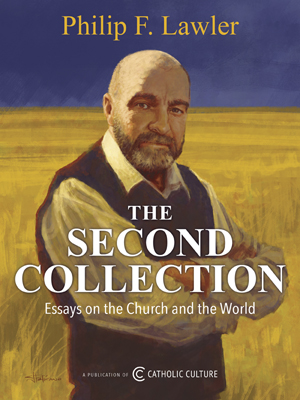Getting in touch with the Saints
By Dr. Jeff Mirus ( bio - articles - email ) | May 26, 2020
Given the perils of our times (and, lest we forget, of all times), I’ve been thinking about rooting myself more deeply in the solid spirituality of the saints. I’ve also been thinking about peppering my prose with concrete examples from the lives of the saints. Long-time readers will notice that I have used more and more salt from Scripture in my writing as time has gone by and, if this is not mere laziness, I hope it reflects greater appreciation for the Word of God. Might a stronger turn to the saints be another step in the right direction?
But anyone who sets off in this direction faces an obstacle in the sheer number of canonized saints (and blessed) that we could choose to know about. One way to survey the field is to follow the liturgical calendar to see what the Church is recommending to us at any given moment. The number of saints commemorated in the calendar was both decreased and updated in the years following the Second Vatican Council. The reasons for these changes were (a) to tighten the focus of the liturgical year on the drama of our salvation in Christ; (b) to drop commemorations of saints in whom there was no longer a very active interest, or about whom very little certain is known; (c) to introduce more recent saints whose example might speak more directly to us today; and (d) to include saints from a greater variety of conditions and vocations—for example lay men and women from many different parts of the world.
Both the new calendar used with the Ordinary Form of the Roman Rite and the older calendar still used with the Extraordinary Form are treasure-troves for renewing our acquaintance with the greatest group of persons who have ever lived. In the Liturgical Calendar on CatholicCulture.org, which follows the current calendar, we take note of the different commemorations in the previous calendar. Perhaps more importantly for today’s discussion, we also typically highlight some saints who are not commemorated (or not universally) but whose “saint days” fall on each date. For there are vastly more holy men and women listed in the Church’s official compendium of saints and blesseds than are commemorated formally in the liturgical calendar in any given time or place.
To do a more thorough job of tracking the saints, and in a more convenient manner, it is possible to consult various reference works. The gold standard here is the well-known Butler’s Lives of the Saints, a compendium first developed and maintained by Alban Butler in the eighteenth century. It has been updated over the years by various editors. For example, the 1956 edition published in four volumes by Christian Classics is still available for between $80 and $170, but of course it is now seriously out of date. The Liturgical Press has tried to keep pace under the editorship of Paul Burns. In the late 1990s they brought out a twelve-volume edition, organized by months, and this was updated to include changes and additions by the addition of a thirteenth volume which ends in 2003. But that will set you back even more—about $350.
Other Ways
There have been, of course, many less-comprehensive collections of saints’ lives, but there is always room for more, especially if easily available at a reasonable price. Just a few days ago a new collection by Dawn Marie Beautner came across my desk from Ignatius Press: Saints: Becoming an Image of Christ Every Day of the Year. Costing just $23.76, this large (7” x 10”) “dust jacket paperback” boasts short biographies of a handful of saints and blesseds for each day of the year, drawn from the much larger list in the 2004 edition of the Church’s official record, the Martyrologium Romanum, plus saints and blesseds since that edition was published.
The biographies, which draw on a number of different sources, range from a short paragraph to about a page in length. So this is a handy overview. I recall here St. John the Evangelist’s supposition that if everything Our Lord did were written down, the world would not have enough room for the books that would be written (Jn 21:25). This might narrowly escape hyperbole because Christ was God and therefore infinite; we are after all still plumbing His depths today. But another way to get at this is to consider the implications of Christ’s life through particular biographies of those who “put on Christ” (Gal 3:27), each in his own way, until it was not they who lived, but Christ in them (Gal 2:20). One benefit of studying the saints, and even of learning to think like a saint, is that we will be brought back to Christ and the Word of God in Sacred Scripture again and again.
So much for skimming the surface. Unfortunately, we are not going to gain a great deal merely from reading surveys of surveys of surveys of huge numbers of saints. The main value of the various compendia is to let us know who is on offer and a little bit about why, so that we can adopt saints that appeal to our own particular personalities and needs. Then we can look for ways to study those saints more deeply, and begin to make friends through prayer with those who inspire us the most. Our task is not to become encylopedias (or, perhaps encyclopediae, for those of us who are especially holy), but to find the inspiration and help we need—in our own particular states in life, and with our own particular strengths, weaknesses, and (God knows!) peculiarities—to conform ourselves more closely to Jesus Christ.
Favorites?
There have been periods in my own life when I have been “personally struck” by the holiness of particular saints. The first time this happened in a mature way was in my junior year in college when the Confessions of St. Augustine was assigned reading in a particular history course. As soon as I began the book, I decided to abandon the assignment schedule. I insisted on reading some of it each night as spiritual reading. Augustine’s spiritual insight into the human personality, including his own personality, was stunning to me, and remains so today.
Another high point of saintly influence came in graduate school where I had the opportunity to select a fourteenth century figure of my own choice for a particular study. I chose St. Catherine of Siena. I can still remember the deep impression made on me by both Sigrid Undset’s wonderful biography and by St. Catherine’s own Dialogue of Divine Providence (which was a dialogue between herself and God) and some of her letters. Then again, the 1966 movie A Man for All Seasons (starring Paul Scofield) made me want to read works by and about St. Thomas More. I don’t recall when I first saw the film, but it became my favorite movie. I re-read More’s commentary on The Sadness of Christ this past Lent. (I had already reviewed it for CatholicCulture.org back in 2016.)
It seems to me that if we are to benefit from the lives of the saints we must recognize that they were not perfect. This limits the value of some excessively pious accounts which focus too much on signs and wonders—but at least this approach can whet the appetite for a deeper study, and of course it is far better than the work of some modern authors who may either fail to recognize sanctity when they see it, or treat it as some sort of anomalous peculiarity. In any case, there can be no hard and fast rules, since each reader needs something a little different when it comes to connecting with the reality of the saints.
But recognizing their imperfections is important because the whole point of becoming a saint is that it is always a work in progress. It was for the saints themselves, and so it must be for us. Therefore, we can gain a great deal by considering saints who tended to share our own kinds of faults: Rashness, greed, impurity, pride, laziness, negligence, whatever. At the same time, even if a beloved saint did not share our particular dominant weaknesses, the very fact that each one struggled toward holiness should always be the main source of inspiration for ourselves.
St. Augustine famously wanted to be a saint “but not yet”. Here I raise my hand as well, but Augustine got over it. St. Francis found it too easy to give away his father’s possessions to help the poor, but he changed radically when he recognized this as a fault. St. Catherine sometimes interpreted temptation as a sign of God’s absence, only to learn she was wrong—and she shared that experience.
Finally, studying the saints ought not, I suppose, to be undertaken primarily for consolation, even if there is plenty of consolation to be found. But the saints usually teach us that consolations, important as they can be at times, are for beginners. They are a means to a higher end, not an end in themselves. To put it another way, reading about he saints can be immensely enjoyable. If that’s all it ever is, we have missed the point of sanctity—yet consolation remains an important part of spiritual development.
Time to find out more about whatever I’ve missed along the way, I think. Surely the saints can help.
All comments are moderated. To lighten our editing burden, only current donors are allowed to Sound Off. If you are a current donor, log in to see the comment form; otherwise please support our work, and Sound Off!








